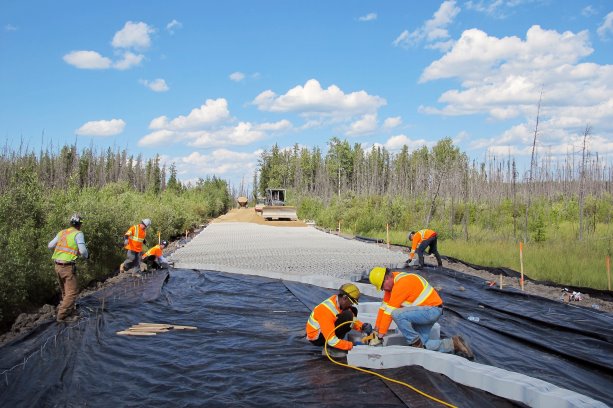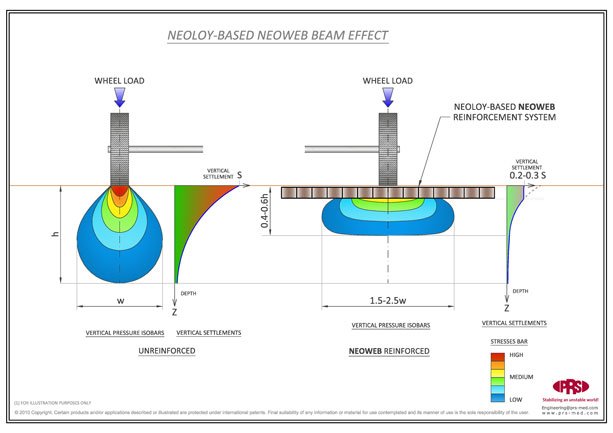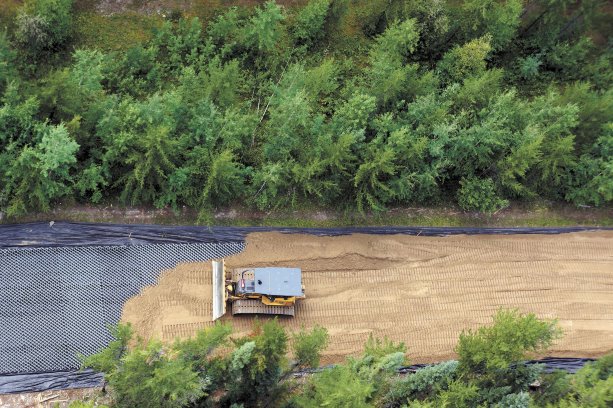Building roads over swamps and muskegs has always been a challenge. Having them stand up to the weight of modern mining and forestry equipment has been even tougher.
PRS-Neoweb, a geosynthetic polymer road base, aims to fill that gap by employing the strength of a honeycomb cell structure, coupled with a tough nano-engineered material. Using the product as an underlayment, almost any material from sand to a variety of aggregates can be used to fill the cells, creating resilient permanent or temporary roads.
Paradox Access Solutions, an Edmonton-based company specializing in access road products and services, is the master supplier of PRS-Neoweb for the Canadian market. The company also builds roads using its own products.
Owner and president of Paradox Access, Marc Breault notes that honeycombed road base products aren’t new. However, Neoloy — the proprietary material made of polyester nano-fibres — is something novel.
"It’s like nylon on steroids," he says. "The material is cheap like nylon and strong like Kevlar. The secret sauce in manufacturing gives it high tensile strength, dimensional stability, resistance to creep and the ability to withstand temperatures from -60 degrees C to +60 degrees C."
The product is delivered in bales containing segments of road 2.5 metres long and up to 12 metres wide. The sections are overlapped and connected using stainless steel staples to form a consistent seam. Sand, aggregate or asphalt are then plowed over top of the cells, filling them and increasing the strength of the structure.
Traditional approaches to roadbuilding in remote access locations include placing layers of fabric or wood mats across bogs and swamps, and letting them settle until the road surface achieves stability. Road builders can also import infill and aggregates, building up a road base on stable ground located somewhere beneath the surface of the bog.
"That’s both expensive and requires delivering products across long distances," says Breault.
"Delivering PRS-Neoweb is far less expensive and we can use whatever aggregate or fill is already found in the area. If a resource company is building a temporary road for exploration, we can come back and collect the material for recycling when they’re through. If they strike oil or gas, it can be left as a permanent access road."
The longest PRS-Neoweb project to date measures just under 20 kilometres.
Successful Canadian projects using the product include MEG Energy’s oilsands operation at Christina Lake, Alta., 150 kilometres south of Fort McMurray.
"The big problem here was the muskeg peat bog and swamps, which turn road construction into an engineering nightmare," says Breault. "Typically you can only build access roads on frozen peat and bog in the winter. This client wanted us to build in the summer to prevent delays in their project."
At from two to six metres, the bog was too deep and poorly drained for soil replacement. Paradox Access technicians first laid a separation barrier made of a geotextile over the peat subgrade for drainage, then placed one to two layers of PRS-Neoweb overtop, depending on the saturation level and depth of the muskeg.
"The product builds on Mother Nature’s geotextiles — the organic fibres of the intertwined roots and vegetation in a swamp," says Breault.
"Locally available aggregate is like gold to us. We used sand from the construction borrow pits, compacted it into the geocells and then capped it with a thin layer of crushed gravel. The MEG Energy access road essentially became a floating road, with tension created by road weight and traffic transformed from a vertical energy to a horizontal energy. "
PRS-Neoweb has also been used at Canfor’s log storage handling yard in Fort St. John, B.C., where Cat 988H loaders weighing more than 43,000 kgs carry loads of logs weighing as much as 1,000 kgs each.
"Between the soggy soil, a high water table, ruts caused by equipment, the weight of the log piles and the brutal freeze-thaw cycles, the ground gets completely annihilated," says Breault.
"We were told by the engineering firm that worked on the project that there’s not another sawmill yard in North America that looks this good."
Breault notes that the product was recently approved for civil projects on Alberta highways, where it can now be used for both road construction and slope stabilization.
"Third-party data shows that a road that we built for an industrial park is still performing after three years," he says.
"The road was built using just PRS-Neoweb, a fill material and only 65 millimetres of asphalt."

1/2
Paradox Access Solutions



Recent Comments
comments for this post are closed